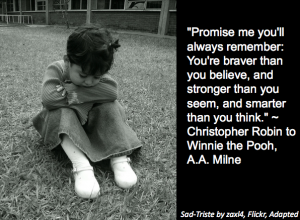“Promise me you’ll always remember: You’re braver than you believe, and stronger than you seem, and smarter than you think.” ~ Christopher Robin to Winnie the Pooh, A.A. Milne
The type of learning I love is challenging, immersive, self-discovering, and self-empowering. We find ourselves faced with a problem where we must employ our tools to come up with a solution that suits us and the situation. At some point in that journey we will feel frustrated, but eventually we will have that “Aha” moment where we think, “Yes! I accomplished this!” We can feel proud of ourselves for employing our higher order thinking skills and other tools like technology to solve a problem that challenged us and others.
Sometimes as teachers we forget that great learning is a journey. Like our students we often want to take short paths versus traveling on the journey. Like our students we want simple and quick answers. Often, in our classrooms we use the tools we have to do simple acts like lifting a pencil to fill in a bubble, using the mouse to click an answer, and using our brains to eliminate the other three answers to find the one the system is looking for. This is what learning is like for many of our students most of the time but I believe as teachers our role is to begin to challenge our students to take the journey. In order to do this we must take our own learning journeys, which can be difficult if we are no longer studying for our graduate degrees or immersed in opportunities where we are challenged. We have to continue to challenge ourselves as learners or we become lazy learners. One way is by learning to use technology to teach our students effectively.
Recently, I was training teachers in Nebraska to use iPads to accomplish short-term goals as part of my 30 Goals Challenge for Educators. They all received new iPads during the training. For many of the teachers, the iPad was a difficult challenge. Many had to set-up iTunes accounts, because they had never had one before. Some had never downloaded an app before. Instead of training them to use the iPad, the technology trainers and I decided to help the teachers accomplish some of the 30 goals using their iPads. In a matter of a few days, the teachers had used their iPads to create digital stories, participate in scavenger hunts around the school, blog their reflections, develop multimedia mindmaps, and collaborate on Google Docs.
During one of the days we were observing the frustrated looks of some of our trainees. We sat in awe thinking about how much they had accomplished with their iPads in a few days that most individuals never accomplish in a year. We realized that our teachers hadn’t realized their accomplishments. We paused the training as I highlighted for them the amazing journey they had just been through and delineated the tasks they could accomplish now with their iPads that they would be able to pass onto their students. We talked about how immersing ourselves with our tools and solving problems or accomplishing tasks is a better way to learn even if it means we get frustrated at times. They assumed that most teachers and students knew how to do all these tasks with their iPads. When the teachers discovered all they had accomplished and how in a few days learning these tasks was an incredible feat, they began to smile at their accomplishments.
They hadn’t gone into the training program to learn to use their iPads, they had actually signed up to accomplish The 30 Goals. The iPad training was an extra we threw in, but our decision had yielded incredible results. We had a room full of teachers who had learned to think creatively and critically with a tool they had never used before. They had accomplished this in a few days and were proud of their accomplishments. They felt confident enough to walk into their classrooms and show their students how to do the same.
One day very soon those teachers will stand in front of their students and they will have to teach their students to use their iPads for student centered learning and hands-on projects. These teachers will have to get their students to use technology to solve challenges and accomplish tasks collaboratively. Teaching their students with the technology will not be an easy journey. Some problems will arise with the technology. Some of their students will not get the instructions as easily as others. It will be a frustrating journey just like the one they had been through but I have the confidence that these teachers will not freak out, blame the technology, or quit their journey of teaching their students to think critically while using technology. All of the teachers completed the training feeling like they accomplished something great and are proud of themselves. They deserve to be. They went on the journey and now they have the mindset and the strength to help their students endure their learning journeys. These are the kind of students we should be raising, learners who will endure a journey to solve problems and think creatively as well as critically.









LOVE this. I see this in some of my younger students, whose parents have chosen to isolate them from technology. They feel weird and can’t keep up with their peers. Luckily, we just plug along and they get it quickly. Great post!
Great article. I could relate to those teachers who were unsure about how they could use the iPad as part of their instruction. I would love to use our professional development time to learn more about iPads.
[…] Digitally Immersed in the Challenges of Learning : Teacher Reboot Camp […]